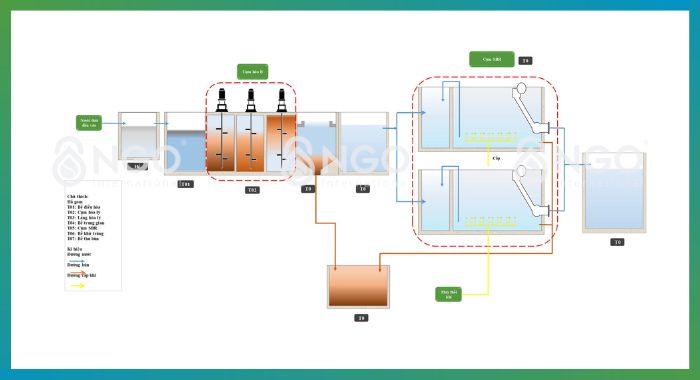SEQUENCING BATCH REATOR (SBR)

1. Operating principle of sequencing batch reactor
Treatment of wastewater by microorganisms tack on suspended solids such as CAS, but the process is designed by operating cycles, each cycle consisting of 5 steps: water supply, agitation, aeration, sedimentation and water discharge. Duration of each treatment cycle (called batches) depending on design.
2. Advantages
- Process is simplier than AAO or CAS beccause aeration tank and settling tank are merged into one tank, OR anoxic tank and aerobic tank are merged into one tank, save more space
- Suitable for small capacity projects or projects that waste water only discharge during a certain imeslot in a day
- No need sludge return from settling tank to Aerobic tank, or from aerobic tank to anoxic tank, avoid microbial leaching in the aeration tank.
- Quality of produce water can be controlled better than CAS AAO because the amound and loading of waste water can be controlled by batch
- Saving some equipment compared to continuous treatment process
3. Disadvantages
- Control the process is difficult, requiring the operator to have higher qualifications to regularly monitor the processing of steps
- There is a risk that produced waste water may come with muds of hard deposit characteristic, cause floating scum
- Because sludge settling tank is combined with aeration tank, sludge concentration may reach high and cause air blower's block
- Not suitable for projects with large capacity, and discharge continously thorough the day
If your business is interested in solution to inlet water treatment, or has a demand for ion exchange materials, please contact NGO via phone number (024) 3566 8225 or email office@8ngo.com for direct consultation.
Source: NGO
-
 Wastewater treatment
Wastewater treatment
-
 A standard domestic wastewater
A standard domestic wastewater
-
 B standard domestic wastewater
B standard domestic wastewater
-
 Pig Farm Wastewater
Pig Farm Wastewater
-
 Textile dyeing wastewater
Textile dyeing wastewater
-
 Paper industry wastewater solution
Paper industry wastewater solution
-
 Textile Dyeing Wastewater & Industrial Washing
Textile Dyeing Wastewater & Industrial Washing
-
 Slaughter wastewater treatment solution
Slaughter wastewater treatment solution
-
 Aquaculture wastewater
Aquaculture wastewater
-
 Starch wastewater
Starch wastewater
-
 Petroleum wastewater
Petroleum wastewater
-
 Beer wastewater
Beer wastewater
-
 Other industrial wastewaters
Other industrial wastewaters
-
 BioPM - Organic Industrial wastewater treatment solution
BioPM - Organic Industrial wastewater treatment solution
-
 MBR solutions
MBR solutions
-
 Conventional activated sludge (CAS)
Conventional activated sludge (CAS)
-
 Moving bed biofilm reactor (MBBR)
Moving bed biofilm reactor (MBBR)
-
 Anaerobic- Anoxic-Aerobic (AAO)
Anaerobic- Anoxic-Aerobic (AAO)
-
 Sequencing batch reactor (SBR)
Sequencing batch reactor (SBR)
-
 Physical & Chemical methods
Physical & Chemical methods
-
 Supply water treatment
Supply water treatment
-
 Cooling system water
Cooling system water
-
 Water treatment for food and Beverage production
Water treatment for food and Beverage production
-
 Ultra pure water supply solution for electronic industry
Ultra pure water supply solution for electronic industry
-
 Pure water supply for pharmaceutical manufacturers
Pure water supply for pharmaceutical manufacturers
-
 Water Supply treatment with ion exchange method
Water Supply treatment with ion exchange method
-
 Ordor Treatment
Ordor Treatment

